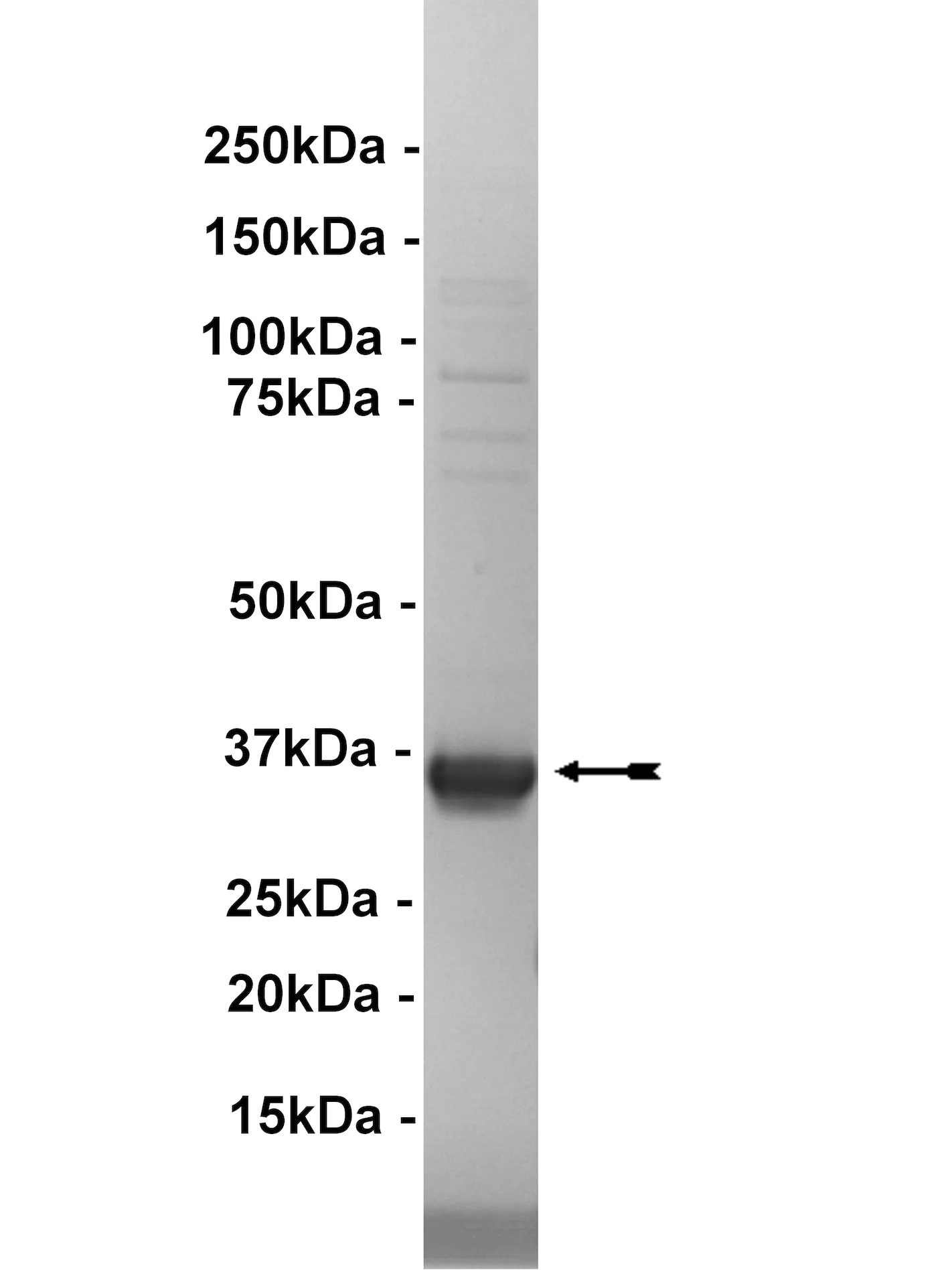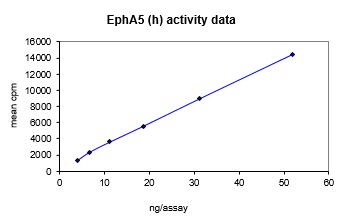EphA5, active Human Recombinant Kinase Protein
N-terminal 6His-tagged recombinant, human EphA5 amino acids 655-956.
Biological information
Background
Eph (erythropoietin-producing hepatocellular) family tyrosine kinase receptors consist of two groups: EphA group members respond to ephrin-A, which is anchored to the cell membrane by glycosylphosphatidylinositol, whereas EphB group members respond to ephrin-B, containing a transmembrane domain. Among them, only EphA4 can cross-respond to both ephrin-A and -B. EphA5 (EHK1, HEK7, CEK7, TYRO4) is widely distributed in CNS. The localization of EphA5 to motor and sensory neurons is consistent with a role of EphA5 in neural plasticity, cell–cell recognition, and topographical orientation of neuronal systems.
GenBank NM_004439
Target class
Kinase
Family
TK
Accession number
NM_004439.4; NM_182472.1
Target Name
EphA5, active Human Recombinant Kinase Protein
Target Alias
EPHA5, EphA5, EHK1, TYRO4, HEK7, CEK7, Hek7
Origin
Human
Theori. MW
37.9 kDa
Affinity tag
6His
Product specifications
Expression system
Expressed by baculovirus in Sf21 insect cells
Purity
Refer to CoA for Purity
Purification method
Ni2+/NTA-agarose
Sample Buffer
Specified activity
Refer to CoA
Application
For Research Only
Storage conditions
6 months at -70°C
Usage disclaimer
For Research Only
Chemical data
Background
Eph (erythropoietin-producing hepatocellular) family tyrosine kinase receptors consist of two groups: EphA group members respond to ephrin-A, which is anchored to the cell membrane by glycosylphosphatidylinositol, whereas EphB group members respond to ephrin-B, containing a transmembrane domain. Among them, only EphA4 can cross-respond to both ephrin-A and -B. EphA5 (EHK1, HEK7, CEK7, TYRO4) is widely distributed in CNS. The localization of EphA5 to motor and sensory neurons is consistent with a role of EphA5 in neural plasticity, cell–cell recognition, and topographical orientation of neuronal systems.
GenBank NM_004439
Compound name
Kinase
Catalog number
14-639
Molecular formula
CAS
MW
Ka
Percent composition
Product specifications
Physical state
Purity (HPLC 214nm)
Retention time (RP18 HPLC)
CMC
Exact mass
Stability
For Research Only
Solubility structure
Kinase Activity Assay Biological information
Background
Eph (erythropoietin-producing hepatocellular) family tyrosine kinase receptors consist of two groups: EphA group members respond to ephrin-A, which is anchored to the cell membrane by glycosylphosphatidylinositol, whereas EphB group members respond to ephrin-B, containing a transmembrane domain. Among them, only EphA4 can cross-respond to both ephrin-A and -B. EphA5 (EHK1, HEK7, CEK7, TYRO4) is widely distributed in CNS. The localization of EphA5 to motor and sensory neurons is consistent with a role of EphA5 in neural plasticity, cell–cell recognition, and topographical orientation of neuronal systems.
GenBank NM_004439
Target class
Kinase
Family
TK
Subfamily
Protein Name
EphA5
Protein Alias
EPHA5, EphA5, EHK1, TYRO4, HEK7, CEK7, Hek7
Accession Number
NM_004439.4; NM_182472.1
UniProt Number
Gene Name
Gene ID
Gene Aliases
Target Species
Human
Kinase Activity Assay Usage
Product Type
Application
Storage Conditions
6 months at -70°C
Usage disclaimer
Kinase Activity Assay Information
Assay Type
Assay Measures
Biological Information
Background
Eph (erythropoietin-producing hepatocellular) family tyrosine kinase receptors consist of two groups: EphA group members respond to ephrin-A, which is anchored to the cell membrane by glycosylphosphatidylinositol, whereas EphB group members respond to ephrin-B, containing a transmembrane domain. Among them, only EphA4 can cross-respond to both ephrin-A and -B. EphA5 (EHK1, HEK7, CEK7, TYRO4) is widely distributed in CNS. The localization of EphA5 to motor and sensory neurons is consistent with a role of EphA5 in neural plasticity, cell–cell recognition, and topographical orientation of neuronal systems.
GenBank NM_004439
Target class
Kinase
Family
TK
Accession Number
NM_004439.4; NM_182472.1
Target Name
EphA5
Target Alias
EPHA5, EphA5, EHK1, TYRO4, HEK7, CEK7, Hek7
Origin
Human
Theoretical MW
Affinity Tag
6His
Product Specifications
Expression system
Expressed by baculovirus in Sf21 insect cells
Purity
Refer to CoA for Purity
Purification method
Ni2+/NTA-agarose
Sample Buffer
Specified activity
Refer to CoA
Application
Storage conditions
6 months at -70°C
Usage disclaimer
For Research Only
Biological Information
Background
Eph (erythropoietin-producing hepatocellular) family tyrosine kinase receptors consist of two groups: EphA group members respond to ephrin-A, which is anchored to the cell membrane by glycosylphosphatidylinositol, whereas EphB group members respond to ephrin-B, containing a transmembrane domain. Among them, only EphA4 can cross-respond to both ephrin-A and -B. EphA5 (EHK1, HEK7, CEK7, TYRO4) is widely distributed in CNS. The localization of EphA5 to motor and sensory neurons is consistent with a role of EphA5 in neural plasticity, cell–cell recognition, and topographical orientation of neuronal systems.
GenBank NM_004439
Target class
Kinase
Family
TK
Accession Number
NM_004439.4; NM_182472.1
Target Name
EphA5
Target Alias
EPHA5, EphA5, EHK1, TYRO4, HEK7, CEK7, Hek7
Origin
Human
Theoretical MW
Affinity Tag
6His
Product Specifications
Expression system
Expressed by baculovirus in Sf21 insect cells
Purity
Refer to CoA for Purity
Purification method
Ni2+/NTA-agarose
Sample Buffer
Specified activity
Refer to CoA
Application
Storage conditions
6 months at -70°C
Usage disclaimer
For Research Only





